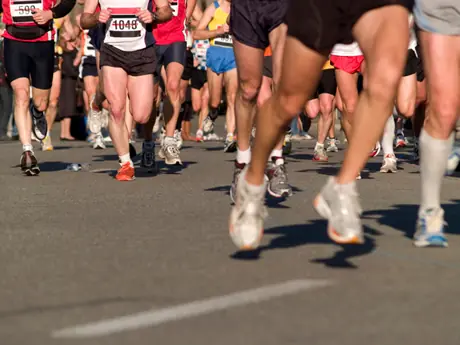
Remember how your mom and your second-grade teacher both seemed to latch onto that sime tired phrase, "You are what you eat"? Back then (and maybe even now, too), that would have made you a giant Hostess cupcake. Here at Cool Running, we've made it our mission to make you into a giant carbohydrate, the single most important fuel for the runner.
Despite the legendary junk food binges of marathon great Bill Rodgers, a good diet really does make you perform better; if you follow the basics outlined here, you may find yourself running faster, longer and more efficiently.
Above all, though, enjoy your food. Notwithstanding all the recommendations you'll find in this section, remember that dining is one of the sublime pleasures of life, right up there with running. Use the information you find here as a set of general guidelines, but don't get so caught up in the specifics that you no longer taste your food.
The basic diet
There's really no such thing as a specialized runner's diet. The type of diet that is good for runners is the same healthy diet as that generally recommended for everyone. Trouble is, most Americans seem to fail miserably at staying within that target diet. Though runners generally maintain a better diet than the average Joe, we all need to be aware of the general proportions of our diets.
A healthy diet is one that is high in carbohydrates, low in fat, and sufficient but not excessive in protein. That translates to about 60 percent of your calories coming from carbohydrates, 25 percent from fat, and 15 percent from protein. As in all things, of course, every individual is different and may respond better to slightly different proportions. There is a significant minority of people, for example, who are insulin resistant to some degree. For them, a diet of 60 percent carbohydrates will create big swings in insulin levels and too much fat storage. In that case, a diet of 50 percent carbs, 25 percent fat and 25 percent protein may make more sense.
That said, beware the faddish 40/30/30 diet or the Atkins diet. While many have lost weight following these diets, they are very poor for runners who would find themselves sluggish from the diminished energy stores of such a low-carbohydrate diet. Cool Running strongly recommends that runners follow a high-energy, high-carbohydrate diet. For most, the 60/25/15 diet is a good rule of thumb.
This of course means that carbohydrates should form the cornerstone of your diet. Since carbos are the most important energy source for long-distance running, it's probably no surprise that so many runners eat hefty portions of pasta, rice, bread and potatoes. Some even find that as they exercise more their tastes change to prefer these foods.
More carbos mean more glycogen
Carbohydrates are stored in the muscles as glycogen, the primary fuel you need to keep you moving. When this efficient source of energy wears out, so do you. You hit the wall and can go no further (often after about 90 minutes or two hours of running).
Carbohydrates come in two flavors: simple and complex. The complex carbos are the ones you're after. These are absorbed slowly into your system and give you a steady energy supply. These are the carbohydrates found in cereal, pasta, vegetables and bread (as a dietary bonus, these foods are also generally high in fiber). These should make up the majority of your diet.
Simple carbos, on the other hand, are basically sugars -- tasty and good for a short-term energy boost since they are quickly absorbed into the bloodstream. Unfortunately, the "sugar high" wears off quickly and usually leaves behind a sugar low, complete with reduced performance and energy. Even so, these sugars do have a place in your diet when they come from natural sources like fruit or juice. The worst offenders, though, are the refined sugars -- those typically found in candy, soda, doughnuts, etc. This is literally junk food; plenty of calories and fat, but no essential vitamins or minerals.
- 1
- of
- 2
Get ACTIVE on the Go


Couch to 5K®
The best way to get new runners off the couch and across the finish line of their first 5K.
Available for iOS | Android







Discuss This Article